Early Asheville Firefighting & Our 1922 American LaFrance Fire Engine
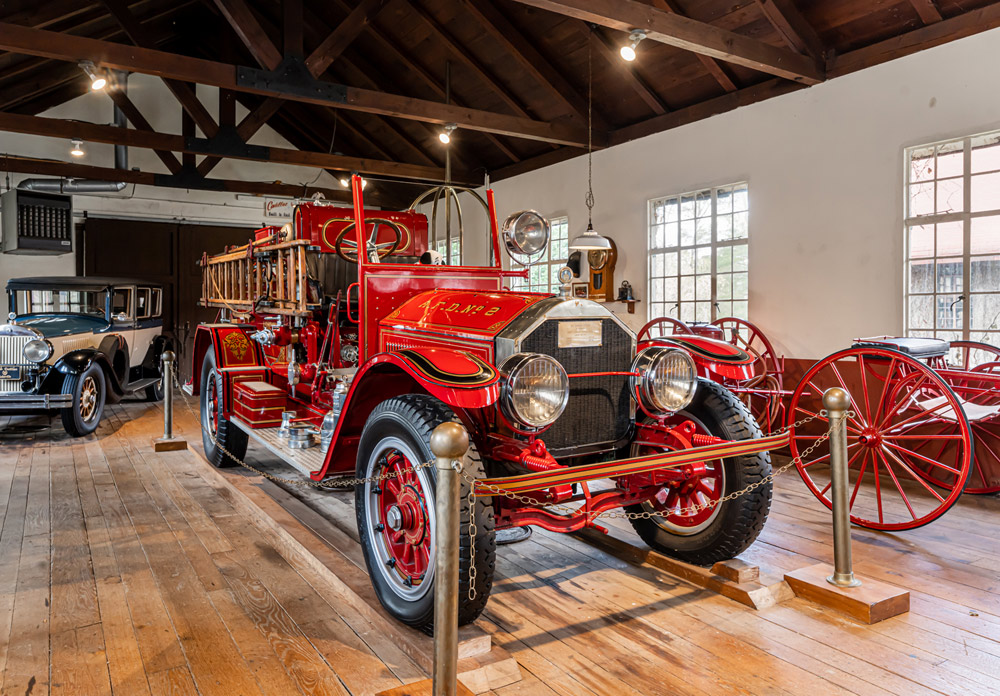
The 1922 American LaFrance fire engine in the Estes-Winn Antique Car Museum has a powerful hold over its visitors, not only as a larger-than-life machine but also in its heroic service to the city of Asheville. It represents the dawn of a new era in firefighting equipment and a lengthy history of service to the city of Asheville.
The city of Asheville has had a long and interesting evolution in its firefighting equipment. In many ways, the fire department evolved more in the decade of the 1920s than in any other era. In the early years of the city, firefighting was simple and not very successful. The population of Buncombe County and Asheville was very spread out at this time, with no waterworks in existence for a ready-made supply of water. If there were a fire, families would be sent running on foot or on horseback to fetch any willing to help neighbors. Buckets or anything that would hold liquid would be used to grab water from a nearby source and then dumped one at a time on the inferno. Wet blankets were also used to cover the windows of any nearby buildings to help prevent the fire from spreading. If a fire was not caught in the early stages and help was not available, the chances of successfully extinguishing the fire were very low.
As Asheville’s population began to grow and people began to settle closer together, it was possible to have enough people to form a dedicated fire department. The first firefighting equipment that was used included hand-drawn carts and hose reels. These carts and hose reels were pushed by two men using a wagon handle, with others assisting in helping to steer, almost like a bobsled team. Some of the equipment these early fire teams would carry might include single ladders, leather buckets, hooks mounted on a long pole to pull down building material, and soda-acid chemical extinguishers, which used a chemical reaction to propel a fire suppressant. The only problem with this hand-drawn equipment was that most of the volunteer firefighters would be exhausted before they had even begun fighting the fire.
With the advent of gravity-fed city waterworks came fire hydrants. It was then possible for these people or horse-drawn hose companies to connect a hose to the discharge nozzle on a hydrant and put a smaller nozzle on the other end of the hose to increase the pressure and fight the fire. Protective clothing consisted of whatever one had on, which, unlike the protective clothing of the day, was made of safer, natural materials. As protective gear began to evolve, rubber, wool-lined long coats, along with boots and leather helmets came around. These items of equipment served more protection from the water being used to fight the fire than protection from the heat and smoke.
Asheville started out like most departments at the dawn of the twentieth century with a fire department made up of volunteer firefighters. To reach the fires, they would arrive on horse-drawn fire carts and wagons. Asheville’s Fire Department was organized on May 2, 1882, and the first truck, a hand-drawn hook and ladder, arrived on November 9, 1882. As of 1880, Asheville only had a population of around 2,600 residents. The first horse-drawn piece of fire equipment, a hose wagon, began service in 1887, with the first horse-drawn hook and ladder appearing in 1890. Asheville’s first fire chief was Captain James Pickney Sawyer, whose father, Isaac Sawyer, had been the first mayor of Asheville. His son, Eugene Sawyer, would bring the first automobile to Asheville in 1901. The fire station at this time was a rough plank building erected next to the jail building behind the courthouse on the square in 1882.
Now that Asheville had an organized company of firefighters, there needed to be a way to alert them that there was an emergency in the city. To gather these men to the firehouse in Pack Square, a large fire bell was installed and would be rung a number of times to sound the alarm. Once at the fire station, they would ready their equipment and horses to pull their equipment to a fire. These horses did yeoman work for the city and were an important part of the original firefighting equipment.

In a 1923 interview conducted by the Asheville Times, L.W. Jeanneret, Asheville’s oldest firefighter at the time, explained the origins of fire horses and their importance within the department. Jeanneret, a Swiss immigrant and watchmaker, had come to Asheville in 1879. He began fighting fires as a volunteer firefighter around 1883. His impression of the fire horses was that they were very sensitive animals whose intelligence matched their human counterparts. Lightweight horses that were around 1,100 pounds were typically chosen to pull the hose wagon due to their speed and endurance for climbing Asheville’s Hills. The city had tried heavier-weight Percherone and Belgian horses, but they were too heavy for the speed needed to pull their equipment.
These early newspaper articles do not mention the use of Dalmatian dogs, which typically led and kept the horses calm on these early fire calls. However, one famous dog owned by a firefighter named “Jack,” a white Spitz dog, served as a station mascot and would run ahead of the fire horses to the fire.
These horses were still being used around the time the city purchased its first motorized fire truck in 1906. The demise of horse service is not attributed to the motorized fire truck itself but to the use of an electric starter rather than a crank start, which allowed the trucks to start and run more easily. Jeannert claimed that the record held by the fire department for hitching up a horse team was 20 seconds, which he claimed was just as good, if not slightly better, than the record for cranking a motor apparatus in the days before the electric starter. When the alarm came into the station, a chain in front of the horses’ stalls dropped automatically, and the horses would rush to their place in front of the wagons. Harnesses were used, which fell into place and had only to be fastened by the firemen. As the city began purchasing motorized trucks, it started to slowly sell off the stable of horses.
Jeanneret relayed one story about several former fire horses that were sold off to a farmer. Whenever the fire bell was rung in the city, the horses would run away from his farm towards city hall, where their former stables were. At the time when this article was written, Jeannert had been serving the fire department for 40 years in 1923.
When the horses were replaced by the universal adoption of motorized fire equipment, it caused an uproar among the firefighters who were loyal to their horses. According to fire department lore, many firefighters abandoned their posts and retired as soon as the city began selling off the horse-drawn equipment, phasing out horse-drawn equipment from 1906 to 1911. In 1911, two additional fire trucks were purchased, one white in color and the other red. Asheville is the first known city in North Carolina to buy motorized fire trucks. At this time, fire trucks began rapidly evolving.
There were several types of trucks, which included “pumpers” and “tankers.” A pumper is a truck that does not include an onboard water tank but rather connects to a fire hydrant on site and pumps high-pressure water at a fire. A tanker truck carries a large water tank so that it can transport and spray high-pressure water at a fire, usually in areas with less access to water or a hydrant. Asheville had a high-pressure water system at the time, with hydrants in Pack Square registering 90 pounds per square inch, and decided to forgo purchasing many pumpers. The tankers purchased by the city from American LaFrance also had a high-pressure pump on them, in addition to a 30-gallon chemical tank and a large water tank.
At this time, Asheville’s population was rapidly approaching 30,000, and the evolving city landscape was moving more towards dense urban development, with people living much closer to each other than before. This required a much more modern approach to firefighting and equipment to match. Mayor Gallatin Roberts had started the process of redesigning the city with the city planner John Nolen as early as 1920, which included a new fire hall. All of the newest fire equipment would go to this new station, and as newer equipment funneled in over the years, the trucks from this post would be dispatched to other posts in the city so that headquarters always had the newest and best equipment.
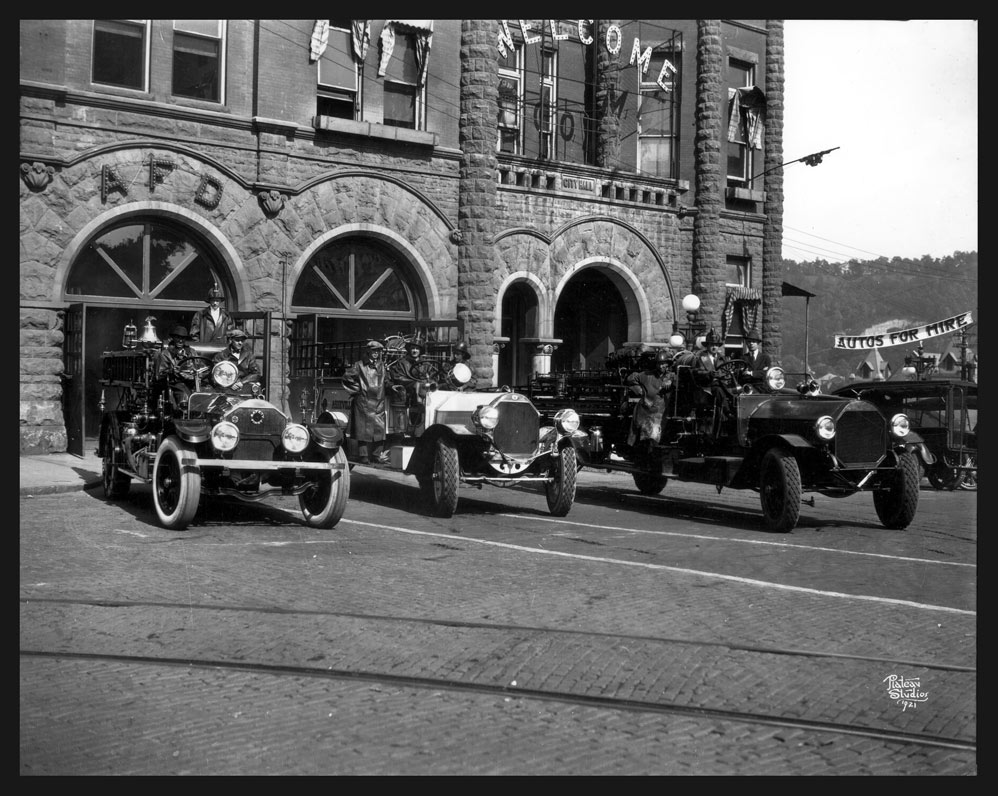
At the beginning of the 1920s, the main fire station, Station 1, was housed at the base of City Hall, adjoining the city market. All of this was located below city hall, which occupied the site of our modern-day county courthouse, give or take. In 1922, Asheville ordered two American LaFrance Type 75 fire engines, one of which would ultimately end up in the collection of Harry Blomberg at his museum, the Estes-Winn Antique Car Museum. The first of these two Type 75 fire engines was delivered on May 22, 1922, and the one in our museum was delivered on November 3, 1922, at the rail station by a front-loaded train car. A representative from the American LaFrance company traveled with the company to train our fire department on its usage and to make sure it was mechanically sound. The fire chief at the time our fire truck was purchased was Alonzo L. Duckett.
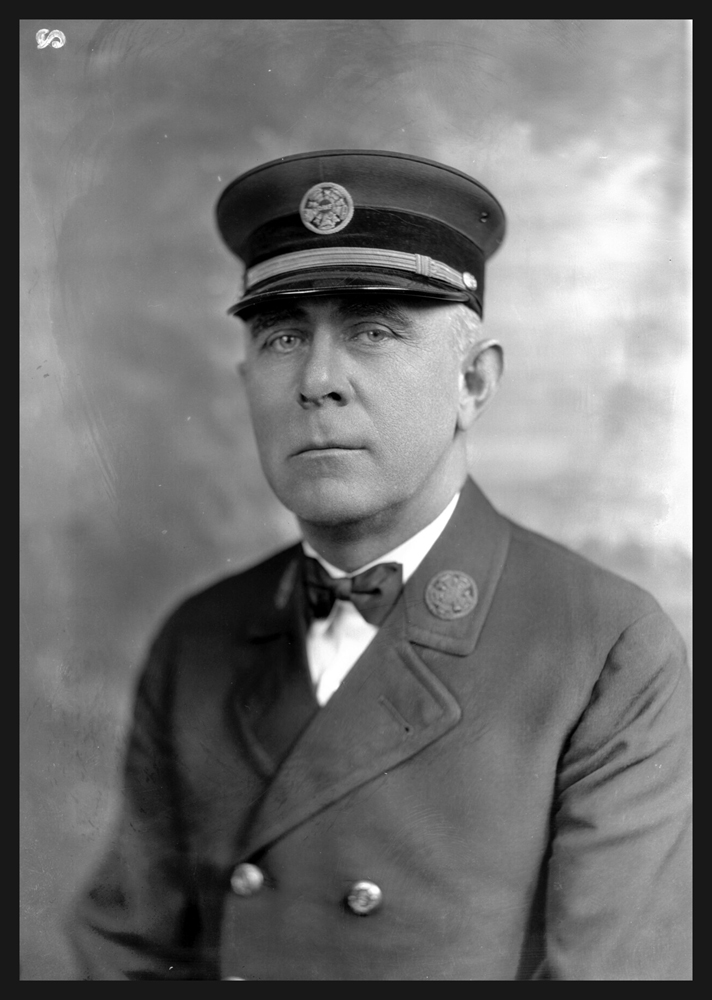
Alonzo Duckett started with the fire department as a volunteer firefighter in 1899. He was known for his tremendous leadership skills, which led the fire department to become one of the most highly accredited in the state. Along with Public Safety Commissioner Robert Lee Fitzpatrick, they greatly modernized the city’s firefighting capabilities. They added a system of alarm boxes or call boxes throughout the city that residents could use to alert a central switchboard.
When it came time for them to buy new fire engines, the city only received two requests for proposals, according to the minutes of the February 1922 Asheville City Council meeting. Duckett and Fitzpatrick received two different quotes: one from the American LaFrance company with two different trucks quoted. One ALF truck was a Type 39 four-cylinder fire truck, costing $10,000, and the second was a Type 75 pumper with a 105-horsepower six-cylinder engine for $12,500. American LaFrance was willing to offer a credit of $1,500 each for the old REO and Seagrave fire engines the department currently owned. This was offered by P.O. Herbert and C.B. Payne – both sales representatives of American LaFrance.
The second quote was from a local Asheville dealer, the Western Carolina Auto Company, for a Mack Type 3 Fire Truck. This truck was quoted at $10,891.75. Western Carolina Auto Company only offered a trade allowance of $500 for the REO Fire Truck and $891.75 for the Seagrave Fire Truck. The Mack Trucks could only pump 500 gallons per minute, whereas the Type 75 American LaFrance fire engine could pump 750 gallons per minute. The city ultimately decided to purchase two American LaFrance pumpers in 1922 for $12,500 each. For comparison’s sake, a Ford Model T in 1922 would have sold for somewhere between $350-500, which the average citizen would have been driving in Asheville.

These American LaFrance fire engines were essentially custom-made vehicles at the time. The first one the city ordered in May of 1922 was #3843, which represents the 3,843rd motorized truck American LaFrance had produced since starting production of motorized fire equipment in 1910. The fire engine that resides in our museum is #4036, ordered on October 21, 1922, and delivered on November 3rd, 1922. To compare production figures to the Ford Model T for 1922, Ford produced 1,301,067 Model Ts in 1922.
By 1924, the city had begun hiring a paid force of firefighters and had moved away from a force composed mostly of volunteers. To commemorate the efforts of these men at the time our 1922 American LaFrance type 75 was purchased, there is a small brass plaque on the basket rack of our fire engine that commemorates the men in office during 1922 who made this engine a reality for Asheville:
Gallatin Roberts – Mayor
Robert L. Fitzpatrick – Public Safety Commissioner
Alonzo L. Duckett – Fire Chief
Benjamin Franklin Mathew – Assistant Fire Chief
Rufus J. Sherrill – City Commissioner
Our fire engine began reporting for service soon after its delivery at Station 1 in Pack Square. By 1926, Asheville had constructed a new fire station in Pack Square, which is still in use today. It was designed by Ronald Green, a noted Asheville architect who designed the Jackson Building, The Bynum House, and Claxton Elementary School, among other buildings in this decade. The ornate tile work on the new Station 1 was done by Samuel Bean, while the masonry and contracting were done by James Vester Miller. James Vester Miller, once a slave in Buncombe County, was one of the first African-American architects and builders in the city of Asheville. This station was opened on March 8, 1926, and in addition to the fire department, it contained the police department, a jail, a gym, a court of law, three fire poles, and a public market. The original station and former city hall were torn down in 1926 also to make way for the new County Courthouse and Douglas Ellington-designed City Hall buildings.
The American LaFrance Type 75 fire engine has a 900 cubic inch T-head inline six-cylinder gasoline engine with 105 horsepower. Its rotary-gear water pump was rated at pumping 750 gallons per minute. Our fire engine was equipped with pneumatic tires and wooden spoke wheels, while other trucks of the era were equipped with solid rubber tires. The front tires measure 37 inches tall, while the rear tires stand 40 inches tall, mounted on 24-inch wheels! It has a rear drive that is connected by a chain drive.
Asheville would go on to purchase four other Type 75 American LaFrance fire engines during the 1920s. Ours was known as Engine No. 2. It was purchased for $12,000 and delivered by rail car from the American LaFrance factory in East Elmira, New York. This would be equivalent to around $218,995 in 2024 dollars. According to American LaFrance sales records from the 1920s, Asheville purchased six American LaFrance fire engines in various models and combinations from 1922 to 1927. The total of all of these combined would have amounted to almost $1.3 million in 2024 dollars!
The fire engine housed in the Estes-Winn Antique Car Museum is a right-hand drive, but there is no exact reason given for why they were produced in this drive configuration. One common explanation is that they had the steering wheel mounted on the right side of the truck so that the driver could see the fire hydrant while approaching the curb. The truth lies somewhat in the middle. The placement of steering wheels had not been standardized, and because the origins of the modern motor vehicle can be traced to Europe, where many countries were driving on the left-hand side of the road of the road, this is another possible reason. Our fire engine was not originally equipped with a windshield, which didn’t appear as standard equipment until the early 1930s. Our windshield was added at a later time. Although it does have a hand crank on the front, it was hardly ever used. It is equipped with an electric starter to turn over and start this massive engine.
In its 40 years of service, our fire engine would have been on site for several notable fires in the city. Shortly after being pressed into service, old No. 2 would have been called on-site to deal with the blaze of the Emporium Department Store on Pack Square. On July 25, 1923, The Emporium Department Store broke out in a large fire during rush hour, and in short order, the entire building was enveloped in flames. Firemen fought for hours before extinguishing it, and damages were estimated at $100,220. City records also indicate that our truck was on-site during the massive fire at Highland Hall on March 10, 1948, when author and artist Zelda Fitzgerald and eight other female patients perished. Around 1927, our fire engine reported for duty at Station 4, located on Merrimon, after serving at headquarters in Pack Square. It would go on to spend much of its career being located at this station. It finished out its career at the Bartlett Street fire station.
Generally, when these trucks were driven to a fire, there would be four firefighters on board. Two of them would ride on the front seat, with two hanging off of the back platform. Several City of Asheville firefighters of note who drove this particular truck were Chief Powell Ball, who joined the fire department in 1951 and became chief by 1971. It was also driven by Chief John Parris (no relation to the author and Asheville Citizen-Times reporter of note) when he was serving at Station 4, the Douglas Ellington-designed fire station on Merrimon Avenue. You will notice next to the fire engine in our museum is one fire pole out of the Douglas Ellington station.
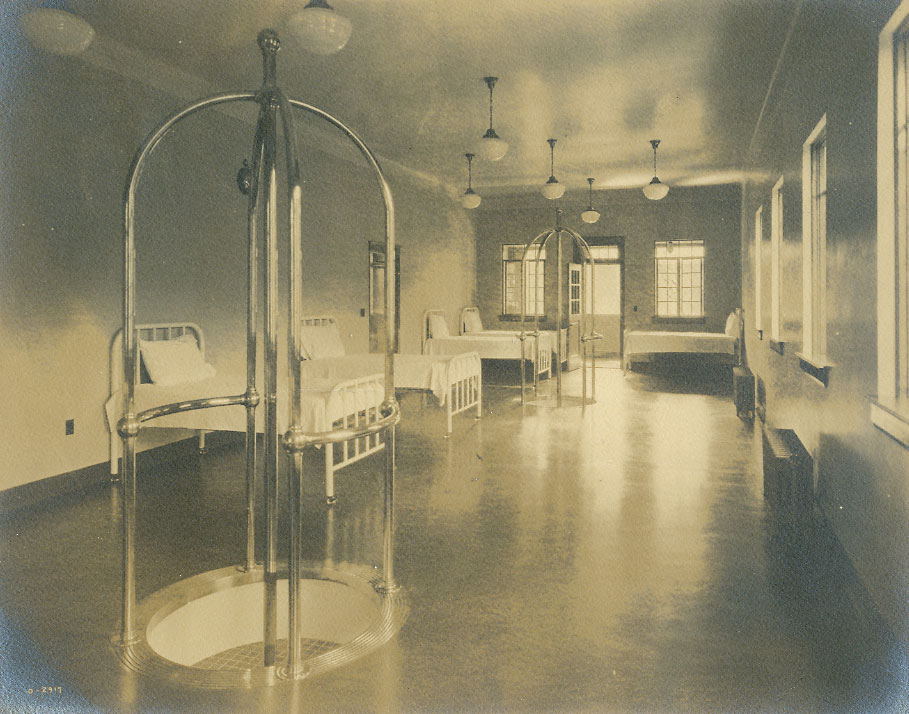
After the truck returned from a fire or other emergency call, maintenance would begin immediately. Fluid levels would be checked, the truck washed, engine tuning and adjustment would be done, and all equipment would be ready for another fire. At this time, the fire hoses were made from a cotton outer lining with a rubber inner liner. If they had been used on a fire call, they would need to be removed from the truck, stretched out on a large hose rack, and left to dry out.
By the end of the 1920s, Asheville was starting to feel the effects of its overzealous spending on city development, with a minor real estate crash occurring in 1927. In 1929, the stock market would crash, crippling many of the world’s markets. Nearly a year later, in November of 1930, Asheville’s most prominent bank and the one that held all of the city’s bonds, the Central Bank and Trust, would collapse and never re-open. This devastated Asheville during the Great Depression of the 1930s, inadvertently saving many older and significant things like our wonderful architecture. Because of this lack of funding in the city, there was no budget to purchase new fire engines on a large scale like had been done in the 1920s. This lack of funding necessitated that these older trucks continue working indefinitely. Our American LaFrance would continue quietly serving the city for a little over 40 years until it was retired in 1964.
By 1962, our fire engine was still in great mechanical and cosmetic condition. Although it had been impeccably maintained, it was becoming more difficult to find parts for and was not as safe to drive as more modern trucks. An article in the Citizen-Times dated May 27, 1962, reported the truck’s lengthy service to the city. At this time, it had been through several upgrades, which included sealed beam headlights and salvaged wheels from another truck in Greensboro that had been junked.
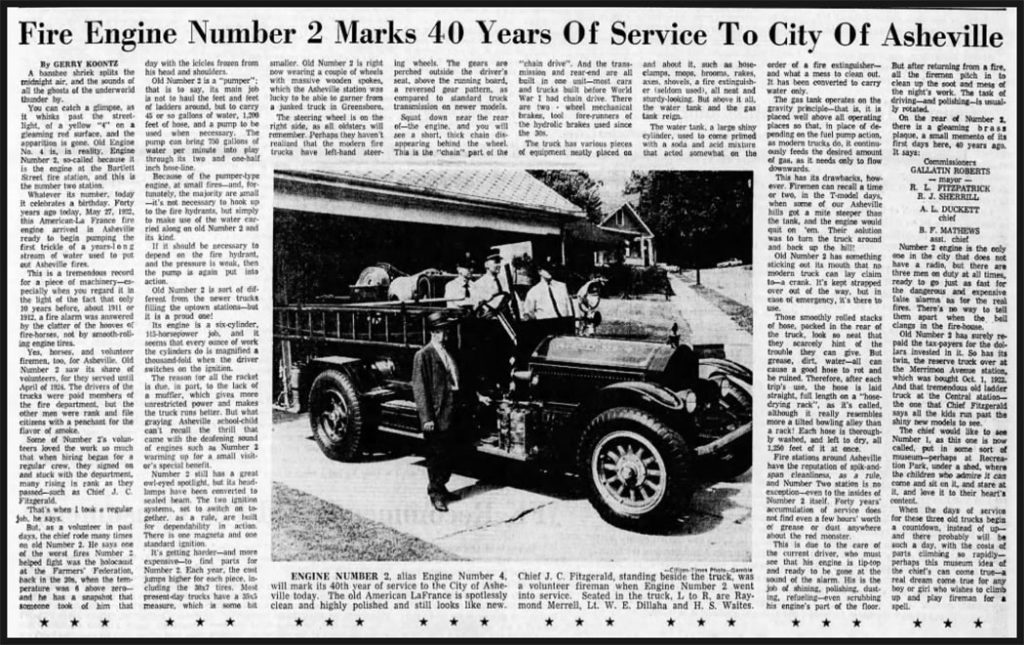
When the city of Asheville finally decided to purchase a new fire engine in 1964, they traded this and several other 1920s American LaFrance fire engines back to their local American LaFrance representative, James A Bailey. Bailey was a native of Asheville and a former firefighter. He served with the Asheville Fire Department for 23 years and was assistant chief from 1939 to 1947, when he was granted a leave of absence to work for the American LaFrance Fire Equipment Co. as a district representative. His father, Captain Bailey, an Asheville Police officer, had been killed by the Charlotte fugitive, Will Harris, on his shooting rampage in Asheville in 1906. Captain Bailey had attempted to intercept Harris and his high-powered rifle and, while taking cover behind a telephone pole, was shot through the telephone pole and killed when his son James was only 3 years old.
It was James Bailey who would sell this old No. 2, our American LaFrance fire engine, to Harry Blomberg on November 9, 1964, for $750 (equivalent to $7,500 in 2024 dollars). For years, Harry had provided a new Pontiac to the fire chief for use as their official vehicle. The city of Asheville would continue to purchase American LaFrance trucks until 1985. In 1985, the company left New York, and production was moved to Virginia. The company operated under a few different corporate owners over the next three decades. During this time, sales and market share steadily declined until 2014, when the company filed for bankruptcy and went out of business.
After receiving his very own former city of Asheville fire engine, Harry brought it to his dealer, Harry’s Cadillac and Pontiac on Haywood Street, where many locals remembered it sitting outside for years. It was later moved after 1966 to his car museum, the Estes-Winn Antique Car Museum, located on the campus of the Biltmore Industries weaving operation in the Grove Park neighborhood. After acquiring the truck, Harry sought out some restoration work on some of the wood parts. Blomberg sought the help of a long-trusted craftsman who had worked on several other cars in his antique collection, Joe Liner. Joe had previously repaired the wooden top bows on the convertible top of Harry’s 1927 LaSalle Phaeton in our collection. The truck spent several weeks being refurbished at Liner’s home in Oakley, where his son Jim Liner fondly remembers playing on it as a child.
The fire engine was said to have been kept at the Estes-Winn Antique Car Museum during the late 1960s to 1970s. It was pulled out of the museum during the winter of 1979 and taken to the body shop at Harry’s Cadillac and Pontiac, high on the hill over Patton Avenue. According to service records for the truck, it had received two paint jobs prior to the reconditioning that Harry and his team were about to give the truck. During the winter, work at the dealer would typically be slow and Harry would take one of the cars out of the museum for recommissioning work to keep his crew busy.
Harry assembled a crack team of technicians that included Bob Allen and David Allison, who both supervised the restoration. Bob Allen was a long-time salesman for Harry and was very involved with the Antique Car Club of America. He had a collection of four antique cars, two of which are still in the museum collection: a 1917 Overland Touring car and a 1913 Ford Model T. David Allison was the manager of Harry’s Body Shop, which has always had a sterling reputation as one of the finest body shops in Asheville.
This fire engine appears to have had a frame-off restoration, but no pictures have surfaced yet. It was brought up to the dealer on the back of a rollback tow truck and dropped off. One of the lead mechanics at the dealer, Tommy Bell, was tasked with restoring most of the mechanical parts. Tommy recalled that the fire engine was in good mechanical shape but needed to have some of the wiring restored. No machine work was necessary on the engine, and they performed mostly routine maintenance, such as pulling off the oil pan to clean the sludge out and cleaning the screen around the oil pump. The truck takes an amazing 5.5 gallons of oil due to the enormous size of the engine. The city of Asheville always followed a strict schedule of maintenance to keep it in top mechanical shape for reliability when an emergency came about.
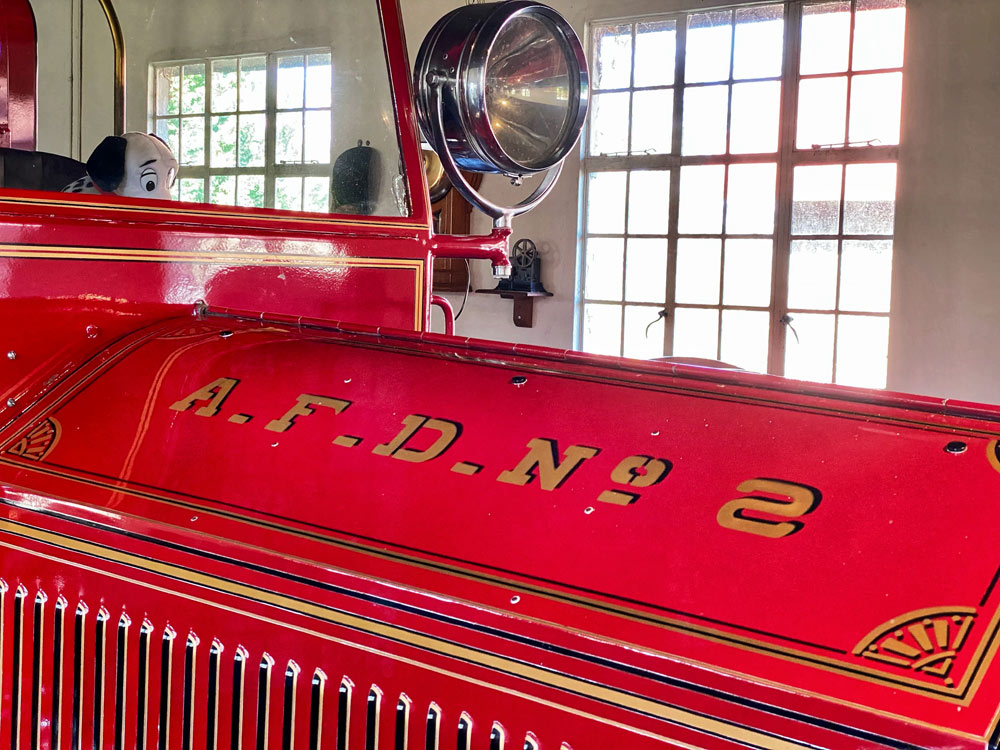
When it came to restoring the paint of the truck, the talents of Ung Sung Kim and his brother, also named Ung Sung Kim, were called upon. Kim and his brother had immigrated to Asheville from Vietnam. They were said to be some of the most skilled bodywork technicians in the shop. Kim and his brother did all of the painting, with most of the pinstriping on the truck done freehand. Mike Allison and George Estes were also charged with helping with much of this work, as well as the mechanical work. George Estes was the front-end alignment tech at the dealer, and Mike Allison was another skilled mechanic. This restoration, which was noted on a brass plaque on the front of the truck, took place from January to May of 1979. Throughout the restoration, the crew remembered Harry Blomberg checking in on them regularly and watching over them very carefully. He seemed to have a real fondness for all of the antique cars in his collection and truly loved them.

After all of the work on the truck was completed, the Harry’s Body Shop crew decided to take Engine No. 2 to the Asheville Christmas Parade. Prior to the parade, it was brought up to the dealer for service. Tommy Bell and Mike Allison were tasked with driving it in the parade. Tommy recalled the terrifying ride down the hill from the top of Harry’s dealer down to Patton Avenue, where the brakes only slightly halted their forward progress. After reaching the bottom of the hill and shaking off the pure terror, they decided they might as well take it through the parade.
This truck has had a long, incredible history with the city of Asheville and the community at large. During its 40 years of service to the city of Asheville, it had numerous first responders who piloted it through the city. It remains on display in Harry Blomberg’s museum so that all can view and dream about its history. Many children in the community have been allowed to climb up in the driver’s seat and have their picture taken, placing their hands on the large, wooden steering wheel and imagining what it would be like to pilot this beast of a truck through Asheville. It no doubt has inspired many would-be car enthusiasts and first responders.
It was present for and ushered in the modernization of firefighting as we know it today. Many visitors to the museum are impressed by the sheer size of this machine and are also struck with gratitude for its service to the city. Something about this machine feels more human than more modern equipment and is somewhat reminiscent of a faithful old horse – always greeting you when you walk out to the stable.
Even today, these fire engines are highly prized among collectors and firefighting apparatus historians. In the United States, North Carolina contains one of the largest fleets of running 1920s-era American LaFrance fire trucks spread across the state. Our fire engine is once again being treated to some long-term maintenance in the form of a new set of tires and refurbishment of its outer rims, which have begun to suffer from rust. Our goal is to get the truck running and return it to the streets of Asheville once again. Although its service may now be just running a circle around the parking lot of Grovewood Village or rumbling up Biltmore Avenue in the Asheville Christmas Parade, we intend to keep this truck alive for at least another 100 years!
Written by Heath Towson, Founder of Mountaineer Motor Tours
Do you have any information? If you remember anything about our 1922 American LaFrance fire engine or if you have any images of it, please email us at info@grovewood.com.
Sources:
- Conversation with Tim Hinshaw – 2/22/24
- Conversation with Hal Fillinger – 3/4/24
- Conversation with Tommy Bell – 1/24/24
Fire Fighting in Buncombe County – Brian Lawrence, 2014
Asheville City Council Meeting Minutes – February 2, 1922
The Society For The Preservation and Appreciation of Antique Motor Fire Apparatus in America, Peckham’s American LaFrance Registration Number Database
The Asheville Times. (July 15, 1923). Asheville Fire Horses. Newspapers.com. Retrieved March 2, 2024, from https://www.newspapers.com/article/the-asheville-times-asheville-fire-horse/142289096/
Asheville Citizen-Times. (November 4, 1922). Fire Truck Delivery – Estes Winn. Newspapers.com. Retrieved March 2, 2024, from https://www.newspapers.com/article/asheville-citizen-times-fire-truck-deliv/142293221/
Asheville Citizen-Times. (May 27, 1962). History of Estes-Winn Fire Truck. Newspapers.com. Retrieved March 2, 2024, from https://www.newspapers.com/article/asheville-citizen-times-history-of-estes/138870256/
Asheville Citizen-Times. (August 19, 1924). James Colvin – Fire Fighter 1920s. Newspapers.com. Retrieved March 2, 2024, from https://www.newspapers.com/article/asheville-citizen-times-james-colvin-f/138936912/
Asheville Citizen-Times. (January 22, 1925). Asheville Fire Department – Equipment added. Newspapers.com. Retrieved March 2, 2024, from https://www.newspapers.com/article/asheville-citizen-times-asheville-fire-d/142289203/
Asheville Citizen-Times. (March 13, 1949). Asheville Fire Dept – Members of Horse Drawn Volunteer Fire Squad. Newspapers.com. Retrieved March 5, 2024, from https://www.newspapers.com/article/asheville-citizen-times-asheville-fire-d/142746226/



